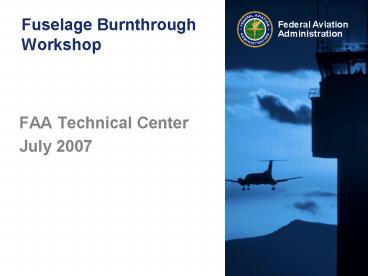Fuselage Burnthrough Workshop - PowerPoint PPT Presentation
Title:
Fuselage Burnthrough Workshop
Description:
Oil Burner Test of Simulated Frame Sections. Fastening Means ... Commenters agreed with intent of rule Major comments involved: Applicable areas of the airplane ... – PowerPoint PPT presentation
Number of Views:55
Avg rating:3.0/5.0
Title: Fuselage Burnthrough Workshop
1
Fuselage Burnthrough Workshop
- FAA Technical Center
- July 2007
2
Fuselage BurnthroughAmendments 25-111, 121-299
- Test Method for Thermal/Acoustic Insulation
- Oil Burner Test of Simulated Frame Sections
- Fastening Means Must be Considered
3
Fuselage Burnthrough
- Requirement provides 4 min
- increased post-crash survival time
- Commenters agreed with intent of ruleMajor
comments involved - Applicable areas of the airplane
- Better Definition of Insulation
- Performance Standard--not Limited to Insulation
- Compliance Time Insufficient
4
Fuselage Burnthrough
- Applicable to both type design and operating
rules - Applies to newly manufactured airplanes entering
part 121 service - Only part 121is affected operationally (Expect
All Airplanes ?20 pax Will Meet anyway to Allow
Future 121 Operation) - N/A to Airplanes with Less than 20 Passengers
- Benefit of Increased Evacuation Time Negligible
for these Airplanes
5
Compliance Time Complications
- Fuel Nozzle Consistency
- Nozzle marking not configuration controlled
- Inconsistent performance with given configuration
- Burner availability
- Burner no longer produced
- Parts for existing burners not readily available
6
Compliance Time Complications
- Nozzle problems lead to research, which delayed
official testing - Fuel nozzle
- Specified 6 gph nozzle not standard as was
believed - Variations exist that affect results
- New 6.5 gph nozzle can be adjusted to give
acceptable results - Nozzle problems heightened industry concerns with
overall test method reliability
7
Compliance Time Extension
- Original Rule Issued in July 03- 4 Year
Compliance Time - NPRM Published in April 06-Proposed 12 month
extension to compliance time - Final Rule (Amendment 121-330) Issued January
2007 with 24 month extension - New compliance date for new production September
2, 2009
8
Applicability of Burnthrough
- What is the Lower Half?
Floor is Usually in the Lower Half
Windows May be in the Upper Half
9
Cooperative Efforts to Simplify Compliance
- Advisory Material-AC 25.856-2
- Individual design reviews with each affected
manufacturer - Additional testing to address new concerns
10
Additional Guidance Pending incorporation in
revised AC
- Pass/Fail criteria
- Requires all samples to pass
- Optimized materials very close to pass/fail
- Additional guidance
- Presumes that tests are valid
- Permits additional testing to obtain typical
performance - Requires all test results to be included in
averaging and average burnthrough time to exceed
4 min.
11
Additional Guidance Pending incorporation in
revised AC
- Cases where improved insulation would not
contribute to fire penetration resistance (ref.
25.856(b)) - Lower lobe cargo doors lower lobe cargo doors
leading into class C cargo compartments, and
having a complete liner on the door meeting the
requirements of the ceiling portion of appendix
F, part III, do not require modification of the
insulation inside the door. - Passenger doors If less than 12 of the door is
in the lower half, no modification to the
insulation is required. If 12 or more, and
insulation is mechanically fastened, add barrier
material to insulation, but no test for
attachment required. If the insulation is not
mechanically fastened.
12
Fuselage Burnthrough
- Additional Guidance
- Wing box The wing box itself does not required
improved insulation (assuming it is insulated).
Note that the insulation on outer skin in the
fuselage above the wing box does require improved
burnthrough protection (lower half only).
13
Insulation in wing root area
14
Fuselage Burnthrough
- Additional Guidance
- Methods of Attachment
- Fasteners
- Fasteners that maintain the barrier, and are
potentially exposed to the fire do not require
test, if they are of a material whose melting
point exceeds the fire temperature. - Other fasteners should be demonstrated by test.
- Fasteners that are not exposed to the fire can be
aluminum or high temperature plastic. - Attachments to the structure need not be tested
if the attachment to the structure is not
critical in maintaining the barrier. - Installation (attachment) tests
- The attachment test is primarily to ensure the
continuity of the barrier, - Heat flux is not measured in this test,
- The installation test shows whether the
attachment materials and methods will prevent
physical fire penetration.
15
Fuselage Burnthrough
- Additional Guidance
- Airplane Geometry
- Window line Some allowance may be possible if
the half-way point intersects the passenger
windows. That is, adding insulation between
closely spaced windows will not contribute to
burnthrough protection in some cases. However,
the variation in airplane design is too great to
generalize this further. - Flightdeck floor Similarly, the halfway point
may be slightly above the flightdeck floor (due
to the change in shape of the fuselage at the
noseit may be acceptable to stop the protection
at the flightdeck floor
16
NexGen Burner
- New Appendix 2 to AC
- Schematic representation
- Basic equipment and facility needs
- Further details likely in Fire Test Handbook































